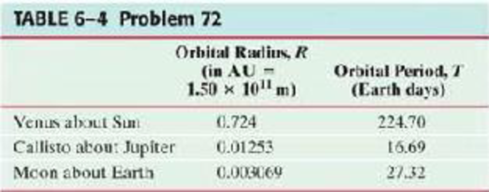
Concept explainers
Newton had the data listed in Table 6–4, plus the relative sizes of these objects: in terms of the Sun’s radius R, the radii of Jupiter and Earth were 0.0997 R and 0.0109 R. Newton used this information to determine that the average density ρ(= mass/volume) of Jupiter is slightly less than of the Sun, while the average density of the Earth is four times that of the Sun. Thus, without leaving his home planet. Newton was able to predict that the composition of the Sun and Jupiter is markedly different than that of Earth. Reproduce Newton’s calculation and find his values for the ratios ρJ/ρSun and ρE/ρSun (the modern values for these ratios are 0.93 and 3.91, respectively).

Want to see the full answer?
Check out a sample textbook solution
Chapter 6 Solutions
EBK PHYSICS FOR SCIENTISTS & ENGINEERS
Additional Science Textbook Solutions
Essential University Physics (3rd Edition)
Conceptual Physics (12th Edition)
The Cosmic Perspective (8th Edition)
Tutorials in Introductory Physics
Conceptual Integrated Science
- Calculate the effective gravitational field vector g at Earths surface at the poles and the equator. Take account of the difference in the equatorial (6378 km) and polar (6357 km) radius as well as the centrifugal force. How well does the result agree with the difference calculated with the result g = 9.780356[1 + 0.0052885 sin 2 0.0000059 sin2(2)]m/s2 where is the latitude?arrow_forwardLet gM represent the difference in the gravitational fields produced by the Moon at the points on the Earths surface nearest to and farthest from the Moon. Find the fraction gM/g, where g is the Earths gravitational field. (This difference is responsible for the occurrence of the lunar tides on the Earth.)arrow_forwardComet Halley (Fig. P11.21) approaches the Sun to within 0.570 AU, and its orbital period is 75.6 yr. (AU is the symbol for astronomical unit, where 1 AU = 1.50 1011 m is the mean EarthSun distance.) How far from the Sun will Halleys comet travel before it starts its return journey?arrow_forward
- The rings of the planet Saturn consist of particles of rock and ice which orbit the = 5.7 × 104ºkg. Suppose a particle has a planet. The mass of Saturn is MSat mass 2,806 kg, and is orbiting at a distance of 2,442 km from the surface of Saturn. The radius of Saturn is ľsat G = 6.67 × 10-1'm². kg¬1.s-2 60, 300 km and Calculate the magnitude of the gravitational attract between the particle and Saturn to 2 sf. Your Answer: Answerarrow_forwardThe mean diameters of Mars and Earth are 6.9×10^3km and1.3×10^4km, respectively. The mass of Mars is 0.11 timesEarth's mass [Mass of Earth = 5.98×10^24kg]. What is: a)The ratio of the mean density (mass per unit volume) of Mars to that of Earth? b)The value of the gravitational acceleration on Mars? c)The escape speed on Mars?arrow_forwardThe gravitational acceleration constant gx on Planet X can be approximated by determining the acceleration of an object assuming Newton's Law of Universal Gravitation. If gx = 3.8 m/s^2 , G = 6.7 x 10^-11 Nm^2/kg^2, and Planet X's radius is 4000 km, what is the approximate mass of planet X? Give answer in kg.arrow_forward
- A planet has a mass of M1, a radius of R1, and a density of ρ1. A second planet has a mass of M2, a radius of R2, and a density of ρ2. This problem will explore the relationships between the surface gravities (g1 and g2) of the planets depending on the relative sizes of their masses, radii, and densities. a) Assume that planet 2 has X times the mass of planet 1, or M2 = XM1. The densities of both planets are the same. Write an expression for the ratio of the surface gravity of planet 2 to planet 1 in terms of X. b)Suppose now the radius of the second planet is Y times the size of the radius of the first planet, or R2 = YR1. Write an expression for the ratio of the surface gravities, g2/g1 in terms of Y assuming the densities are the same. c) Suppose now M2 = 8M1 and ρ2 = 8ρ1. What is the ratio of g2/g1 now (here we want the actual number; because you are writing a ratio, the number will be unitless)? d) Now suppose R2 = 10R1 and ρ2 = 10ρ1. Find the ratio of g2/g1 (again as a number…arrow_forwardTwo planets have density in the ratio 2:3 and Hadii in the ratio 1:2 Then the ratio of acceleration due to gravity at their surface isarrow_forward
 Classical Dynamics of Particles and SystemsPhysicsISBN:9780534408961Author:Stephen T. Thornton, Jerry B. MarionPublisher:Cengage Learning
Classical Dynamics of Particles and SystemsPhysicsISBN:9780534408961Author:Stephen T. Thornton, Jerry B. MarionPublisher:Cengage Learning Principles of Physics: A Calculus-Based TextPhysicsISBN:9781133104261Author:Raymond A. Serway, John W. JewettPublisher:Cengage Learning
Principles of Physics: A Calculus-Based TextPhysicsISBN:9781133104261Author:Raymond A. Serway, John W. JewettPublisher:Cengage Learning Physics for Scientists and Engineers, Technology ...PhysicsISBN:9781305116399Author:Raymond A. Serway, John W. JewettPublisher:Cengage Learning
Physics for Scientists and Engineers, Technology ...PhysicsISBN:9781305116399Author:Raymond A. Serway, John W. JewettPublisher:Cengage Learning Physics for Scientists and Engineers: Foundations...PhysicsISBN:9781133939146Author:Katz, Debora M.Publisher:Cengage Learning
Physics for Scientists and Engineers: Foundations...PhysicsISBN:9781133939146Author:Katz, Debora M.Publisher:Cengage Learning University Physics Volume 1PhysicsISBN:9781938168277Author:William Moebs, Samuel J. Ling, Jeff SannyPublisher:OpenStax - Rice University
University Physics Volume 1PhysicsISBN:9781938168277Author:William Moebs, Samuel J. Ling, Jeff SannyPublisher:OpenStax - Rice University Stars and GalaxiesPhysicsISBN:9781305120785Author:Michael A. Seeds, Dana BackmanPublisher:Cengage Learning
Stars and GalaxiesPhysicsISBN:9781305120785Author:Michael A. Seeds, Dana BackmanPublisher:Cengage Learning





